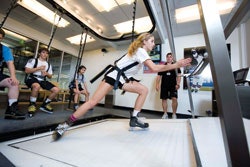Manhattan's Chelsea Piers sports and entertainment complex becomes New York City's largest commercial consumer of 100 percent wind power.
 Photo of a young woman working out at Chelsea Piers
Photo of a young woman working out at Chelsea Piers
Since Manhattan's Chelsea Piers - a 28-acre, one-million-square-foot sports and entertainment complex that extends over the Hudson River - can't simply harness the wind blowing off the harbor, the facility's owners decided to do the next best thing: In October, Chelsea Piers began purchasing wind power in the form of renewable energy credits (RECs) that are equal to 100 percent of the facility's energy usage. The strategy offsets 13,344 metric tons of electricity-related greenhouse-gas emissions, which is the equivalent of taking almost 3,000 vehicles off the road or planting nearly 13,000 acres of trees.
"We use a lot of electricity, and it seemed like the right thing to do," says Erica Schietinger, vice president of corporate communications for Chelsea Piers and head of the companywide Green Team - a group of employees from various departments assigned to make the complex even more environmentally friendly. "The feeling was, 'If we're going to do it, we're going to do it all the way.' So rather than say we were going to do 10, 20 or 30 percent wind power, we went with 100 percent."
 100% of Chelsea Piers' energy is offset by green-e power generated from wind.
100% of Chelsea Piers' energy is offset by green-e power generated from wind.The move (nothing more than an accounting shift, really) is "quite simple" for any type of commercial facility, regardless of size, says Julie Clendenin, spokesperson for the Washington, D.C.-based American Wind Energy Association. "You sign up for the program with your local utility, which meters your power as usual and then makes sure it is purchasing the equivalent amount of wind power. This just gives people an option to express their support for clean, domestic and renewable energy."
Chelsea Piers is now considered New York City's largest commercial consumer of 100 percent wind power. Its energy provider, ConEdison Solutions, obtains wind in the form of RECs generated by wind farms around the country and sells those credits to the facility and other customers. Purchasing RECs affects how much renewable energy is produced in the energy grid; the more credits sold, the more wind energy produced.
 Photo of a young woman running on a treadmill at Chelsea Piers
Photo of a young woman running on a treadmill at Chelsea PiersWind could initially increase Chelsea Piers' annual electric bill by an estimated $100,000, according to Schietinger. Or not. "At every level, people who work here have started thinking about conserving and doing things differently, which is a nice byproduct," she says. "So will we end up spending $100,000 more a year? I don't know, because people are much more apt to pull doors shut or turn off the lights now. We have 300 employees, and if everybody does that sort of thing, the savings add up."
Chelsea Piers recently reported a 40 percent reduction in bulk trash over three months after acquiring a disposal machine that turns food waste into water and carbon dioxide before it is consumed by the sewer system. Elsewhere, all interiors are illuminated by high-bay light fixtures with energy-efficient low-wattage bulbs, and restrooms and locker rooms feature low-flow showers and toilets.
 Photo of the pool at Chelsea Piers
Photo of the pool at Chelsea PiersBut among all green strategies, RECs are gaining the most momentum. The findings of a poll conducted by Hart Research Associates and released in May indicate that 75 percent of American voters favor a national renewable electricity standard (RES) that would require utilities to generate at least 25 percent of their electricity from renewable energy sources such as wind and geothermal heat by 2025. A recent report by the U.S. Department of Energy's Energy Information Administration (EIA) states that a national RES would reduce fuel prices for all sectors, have minimal cost impact on power prices and reduce carbon dioxide emissions immediately. Such standards currently exist in 28 states, according to the AWEA, but there is no national standard.
"If I had to choose between a gym that I knew was getting all of its electricity from renewable energy and just another gym, that would make a difference to me," says Clendenin, who purchases RECs to offset the power generated in her home. "And I think there are a lot of consumers out there for whom that would make a difference, too. Consumers are looking for green options in every part of their lives."




































